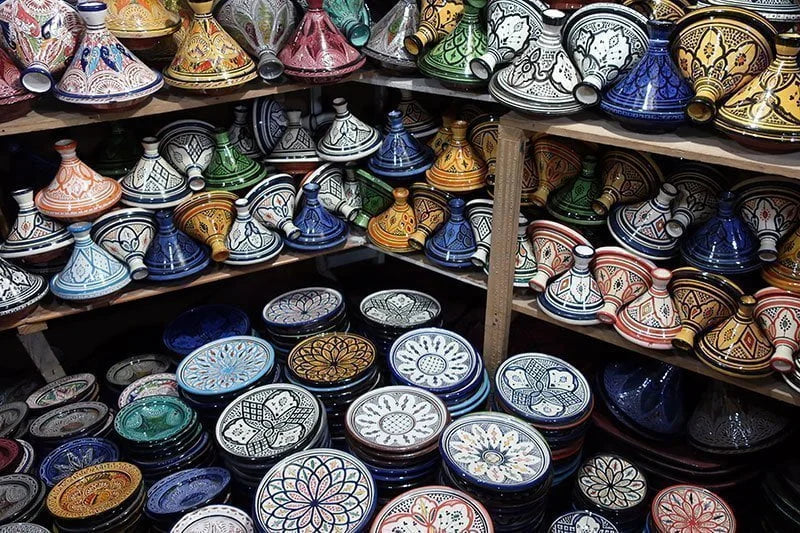The Rich History of Moroccan Pottery
Moroccan pottery has a long and fascinating history that spans thousands of years, shaped by various techniques and influences from different cultures and civilizations. From the ancient Berber coil pottery to the intricate zellij tiles and the vibrant blue pottery of Fez, Moroccan ceramics have evolved over time, reflecting the country's diverse cultural heritage.
Ancient Moroccan Techniques and Influences
The origins of Moroccan pottery can be traced back to prehistoric times, with archaeological discoveries revealing the existence of pottery vessels from as early as the Neolithic period, around 10,000 BCE[1]. These early pots were made by hand using simple techniques, such as coiling and molding the clay, and featured minimalistic designs like geometric patterns or simple lines[1].
As time progressed, Moroccan pottery witnessed significant developments during the Carthaginian and Roman eras. The introduction of the potter's wheel around the 5th century BCE allowed for the creation of more symmetrical pieces with intricate designs[1][4]. The Romans further refined the methods for producing pottery, introducing techniques like "terra sigillata" with impressed motifs and light glazing[4].
The Glorious Islamic Period
During the Islamic period, Moroccan pottery experienced a significant transformation, as Islamic designs and calligraphy became integral to the artistic expression[1]. The arrival of Islamic conquerors in the 7th century brought with them techniques and influences from various parts of the Muslim world, resulting in the development of distinct styles and designs[1].
One notable innovation during this period was the introduction of tin glazing, a technique that added vibrant colors and intricate patterns to the pottery[1]. The use of calligraphy and geometric patterns also became prominent, reflecting the Islamic emphasis on religious motifs[1]. These innovations not only elevated the aesthetic appeal of Moroccan ceramics but also imbued them with deeper cultural and religious significance.
The Golden Age of Moroccan Pottery: The Marinid Dynasty
The Marinid Dynasty, which spanned from the 13th to the 15th century, marked the apex of Moroccan pottery production in terms of quality, innovation, and diversity[1]. Under the Marinid rulers, Moroccan potters explored new techniques and experimented with different forms and designs, developing a distinctive style characterized by intricate geometric patterns, floral motifs, and calligraphic inscriptions[1].
The pottery of this era often featured vibrant colors, including cobalt blue and lustrous green, achieved through the application of glazes and intricate firing processes[1]. The Marinid artisans also excelled in creating pottery adorned with raised motifs, giving their works a three-dimensional quality that was highly prized[1]. This Golden Age of Moroccan Pottery left a lasting legacy in the artistic world and contributed to the rich cultural heritage of Morocco.
Zillij: The Art of Moroccan Mosaic Tiles
One of the most iconic and enduring traditions of Moroccan pottery is the art of zillij, the hand-cut ceramic tiles used to decorate architecture, floors, and walls with intricate geometrical patterns[4]. Zillij dates back hundreds of years and draws inspiration from Persian ornamentation and Roman mosaics[4].
The process of creating zillij tiles involves cutting ceramic pieces into precise shapes and arranging them into complex geometric designs. The tiles are then fired and glazed, resulting in a vibrant and durable surface[4]. Zillij can be found in many of Morocco's most famous buildings, including the Alhambra and Alcazar palaces in Spain, which were influenced by Moorish architecture[4].
The Diversity of Moroccan Pottery Styles
Moroccan pottery is defined by its vibrant colors and complex geometric designs that emanate from circular patterns with extensive repetition, symmetry, and changes in scale[4]. The artistic tradition is usually distinguished between two areas: urban and rural[4].
Urban pottery centers like Fez, Safi, and Rabat have developed their own unique styles and techniques. Fez is known for its blue pottery, called "Bleu de Fez" by the French, which dates back to the 13th century[4]. Safi, located on the Atlantic coast, is famous for its yellow clay pottery decorated with curving black lines and overglazed with a greenish-blue color[4]. Rabat pottery has been greatly influenced by French colonists, combining traditional Islamic designs with more contemporary styles[4].
In contrast, rural pottery, particularly in the Rif mountains, is characterized by modelled pottery crafted solely by women using ancient techniques[3]. These pieces are utilitarian in nature, meeting the needs of rural life, and often bear the marks of belonging to each tribe[3]. The modelled pottery of the Rif is considered the guardian of this ancient art, as the techniques and patterns used today are very close to those of their origins[3].
The Challenges of Preserving Moroccan Pottery
Despite the rich history and enduring traditions of Moroccan pottery, the craft faces challenges in preserving and promoting its legacy. The declining number of potters and the competition from mass-produced ceramics have threatened the survival of traditional techniques[1].
However, efforts are being made to revive and sustain Moroccan pottery. Craft cooperatives, such as those created by the Service of Indigenous Arts in 1940, have helped to employ artisans and promote the sale of traditional ceramics[2]. Today, Moroccan pottery continues to be a source of pride and a testament to the country's cultural heritage, with artists and artisans working to keep the traditions alive and adapt them to modern times.
In conclusion, the history of Moroccan pottery is a rich tapestry woven with the influences of various cultures and civilizations. From the ancient Berber coil pottery to the intricate zillij tiles and the vibrant blue pottery of Fez, Moroccan ceramics have evolved over time, reflecting the country's diverse cultural heritage. Despite the challenges faced by the craft, Moroccan pottery remains a source of pride and a testament to the enduring spirit of its artisans.
Citations:
[1] https://kechart.com/the-rich-history-of-moroccan-pottery-and-ceramics/
[2] https://tuyya.com/blogs/journal/historical-journey-moroccan-pottery
[3] https://www.memori.studio/en/savoir-faire/the-modeled-pottery-from-the-moroccan-rif-mountain
[4] https://alomagazine.com/the-vibrant-world-of-moroccan-pottery/


